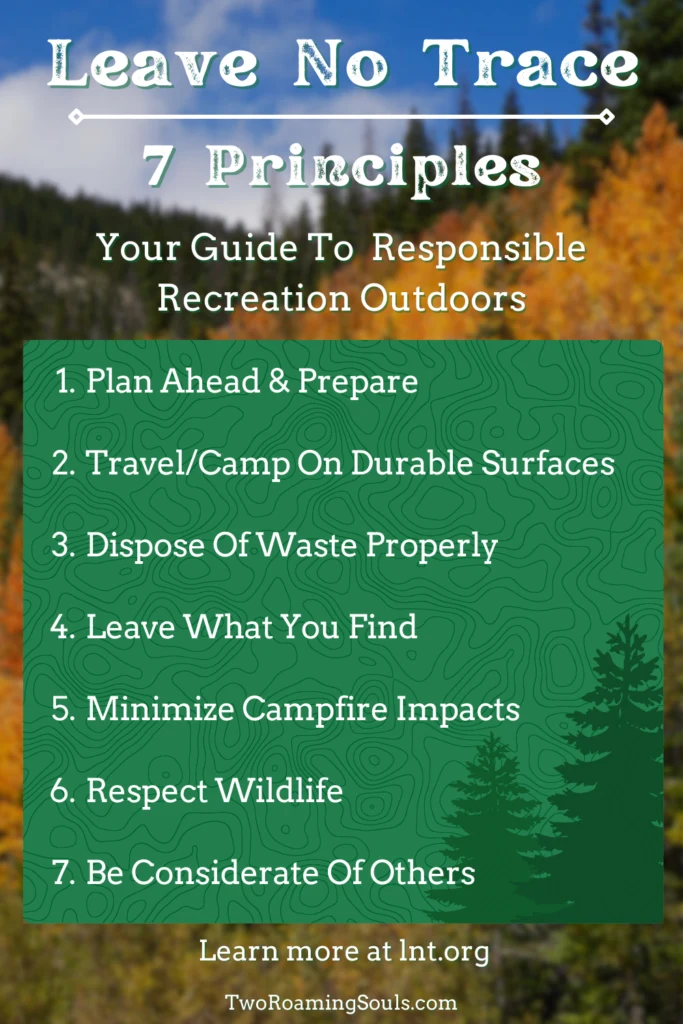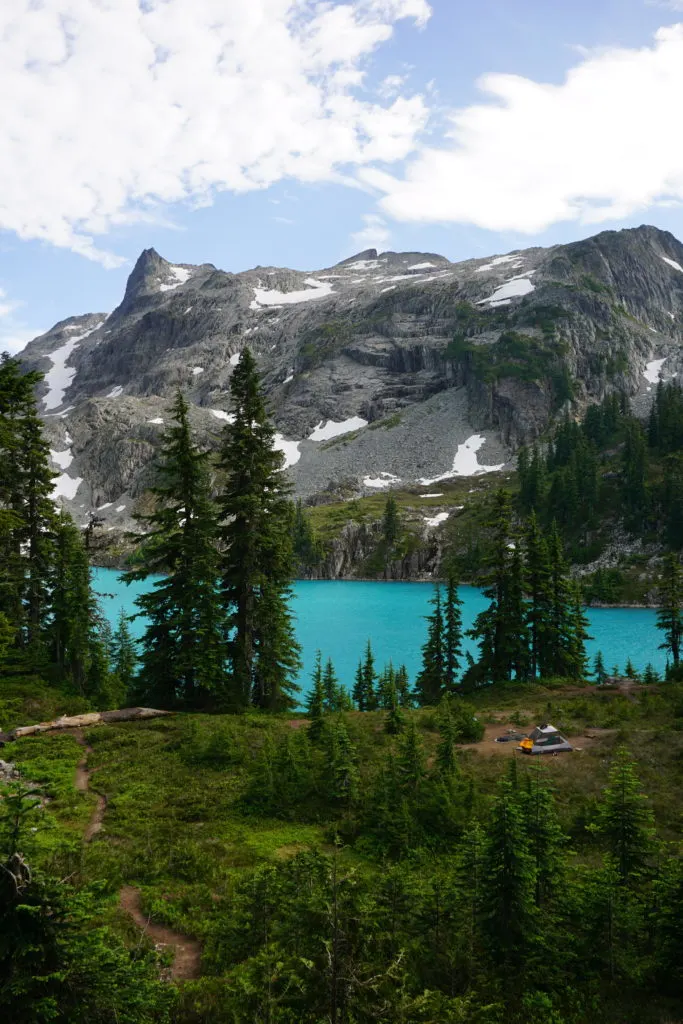
Leave No Trace ethics are a guiding set of principles to help preserve delicate natural resources.
There are seven simple principles you should follow every time you enjoy outdoor recreation. They are pivotal for reducing your impact on the lands you visit, so they remain just as beautiful and pristine for generations to come.
Leave No Trace principles were designed specifically for backcountry travel, but once you have learned them, you will find it easy to apply them to every part of your life. Whether you are visiting your local municipal park, boondocking on public lands, or enjoying your own backyard.
Leave No Trace 7 Principles
These simple, actionable guidelines make responsible recreation easy for everyone.
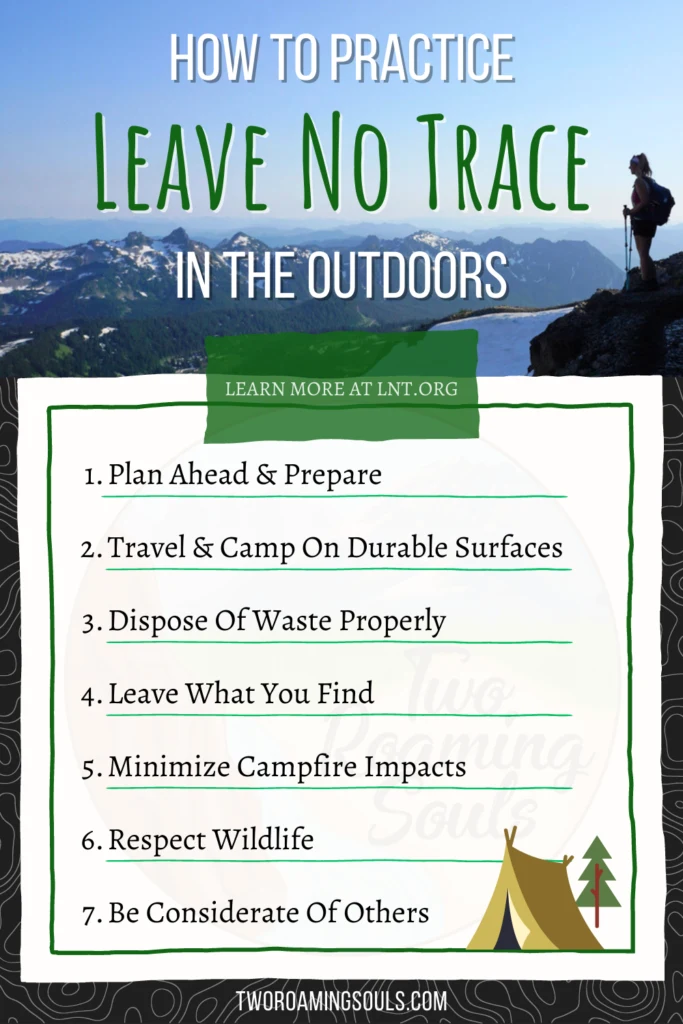
“The Seven Principles of Leave No Trace provide an easily understood framework of minimum impact practices for anyone visiting the outdoors.” – LNT
1. Plan Ahead & Prepare
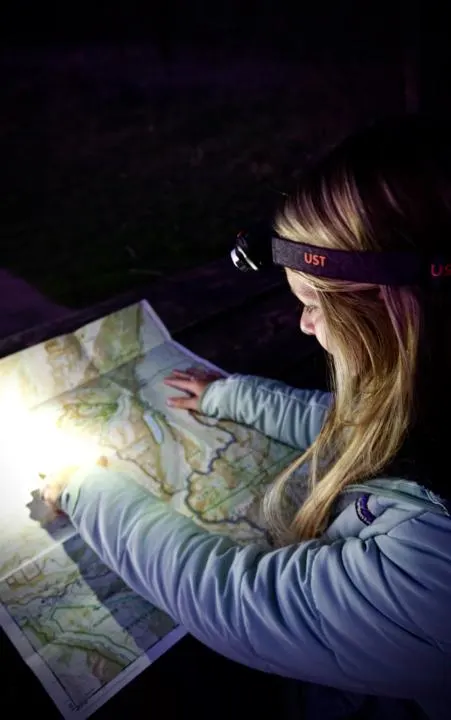
Protecting natural resources can begin before you even leave your house.
When you are well prepared for an outdoor adventure, you are more likely to stay safe and follow best practices. It’s poor planning that often results in desperate situations and abandoning LNT principles.
Some highlights of good planning include:
- Plan activities that match your (& your group’s) skill and ability level.
- Learn about the area you plan to visit from land managers, maps, and literature (climate, terrain, regulations/restrictions, regional best practices).
- Buy or rent appropriate gear/clothing for the trip.
You can use a variety of sources to plan your outings.
Official Land Management Websites
A great place to start is on the website of the land managing agency. This is usually the best place for basic information: hours of operation, recreation opportunities, maps, current advisories, and specific rules/regulations.
For example, in the US you might use official websites for National Parks Service, State Parks, Bureau of Land Management, US Forest Service, US Fish and Wildlife.
Local Ranger Offices
You can also visit local ranger offices or visitor centers for in-person assistance, and hard copies of maps, etc.
Blog or Other Publications
Lastly, you can read blogs (like ours) or other publications like guide books, magazines, and websites for even more information to help planning and preparation.
These types of resources are usually best for first-hand experience, complete travel guides, gear advice, and unique tips.
2. Travel & Camp On Durable Surfaces
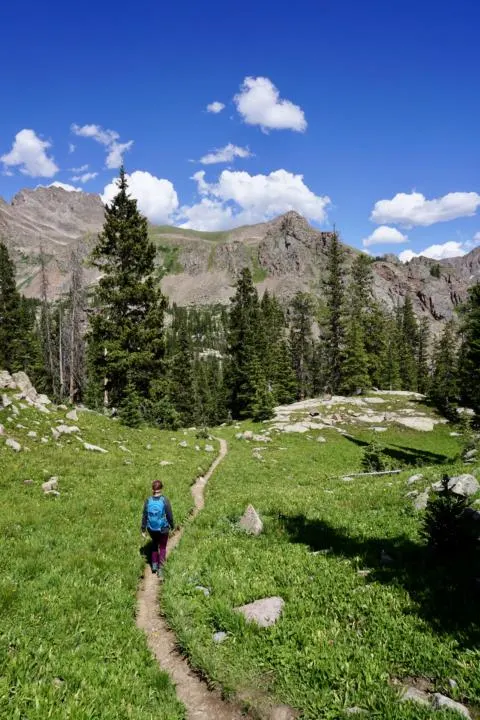
This is one of the most important ones to protect delicate resources. If everyone just walked and set up camp wherever they please, there would be rampant environmental damage.
- Stay on existing trails, roads, and campsites whenever possible.
- Travel on durable surfaces like rock, gravel, dirt, and sand.
- Choose campsites at least 200 feet (70 paces) from water and trails.
On-Trail Travel
Trails and roads are a necessary evil that allows large numbers of visitors in the outdoors. While concentrating traffic and impact to just a single disturbed path. Always stay on designated trails and roads when possible.
“It is better to have one well-designed route than many poorly chosen paths.” – LNT
When taking rest breaks, choose spots with durable surfaces.
Off-Trail Travel
However, sometimes off-trail travel is necessary, like when making camp and moving between your camp kitchen, water source, food storage, and searching for bathroom privacy.
Off-trail travel, however, is guided by different principles.
The goal is to choose routes based on surface durability to avoid creating new paths that others will follow. Surface durability refers to the ability of land or vegetation to withstand wear or remain in a stable condition.
Things like rock, gravel, sand, and dry grasses have high durability and are most resistant to trampling. Ice and snow are good travel surfaces (assuming proper gear and preparation) and only result in temporary effects.
All other vegetation should be avoided for off-trail travel. But if you must, spread out your travel to avoid creating new paths.
And probably the most delicate of all surfaces is the cryptobiotic soil crust found in the desert. It appears like a blackish and lumpy crust on the surface of the desert.
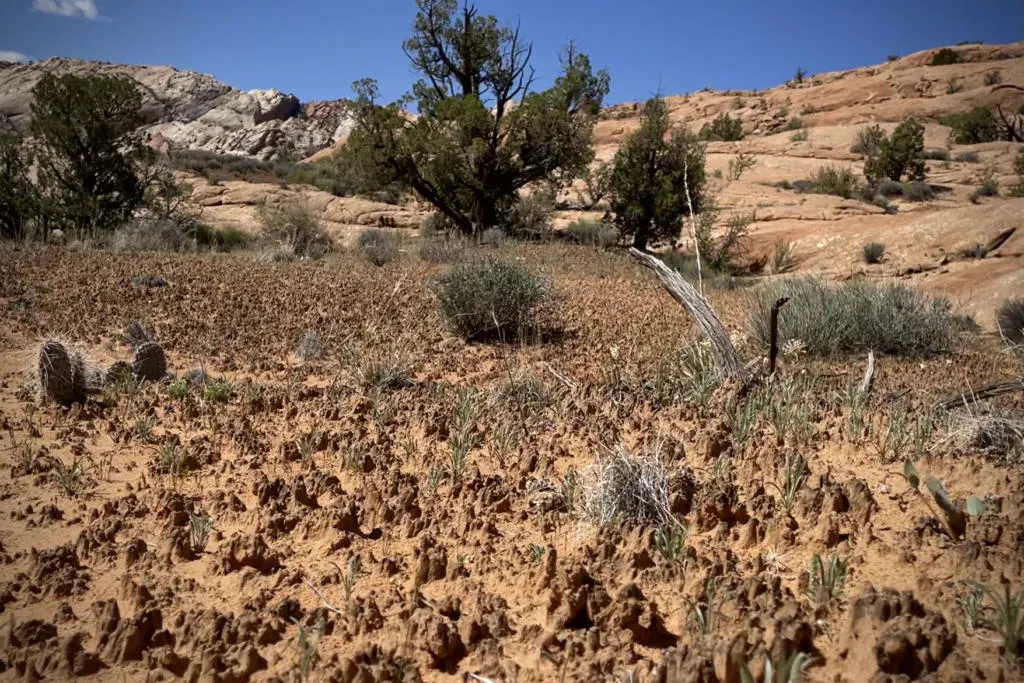
This delicate layer comprised of tiny organisms is essential for desert ecosystems for retaining moisture and preventing erosion. A single footstep of damage can take hundreds of years to recover.
Choosing Campsites
Choose campsites that are at least 200 feet (70 paces) from trails and water sources. This lessens your visible disturbance to other visitors and ensures wildlife has uninterrupted paths to water.
A good general rule is making camp in previously disturbed campsites. You can identify previously disturbed campsites in areas that already lack vegetation. The objective is to “confine impact to places that already show use and avoid enlarging the area of disturbance.” – LNT
There are different guidelines for camping in remote pristine areas (like places where no visible campsites exist). The concept here is practically the opposite. Lessening your campsite’s impact to the point that future visitors will not choose the same site. But most people are unlikely to visit places where no previous campsites exist.
3. Dispose Of Waste Properly
Here are the basic guidelines for disposing of waste properly.
Trash
The common mantra is ‘Pack-It-In, Pack-It-Out’. Trash of any kind should be packed out with you. And bonus points for carrying out trash that other people have left behind.
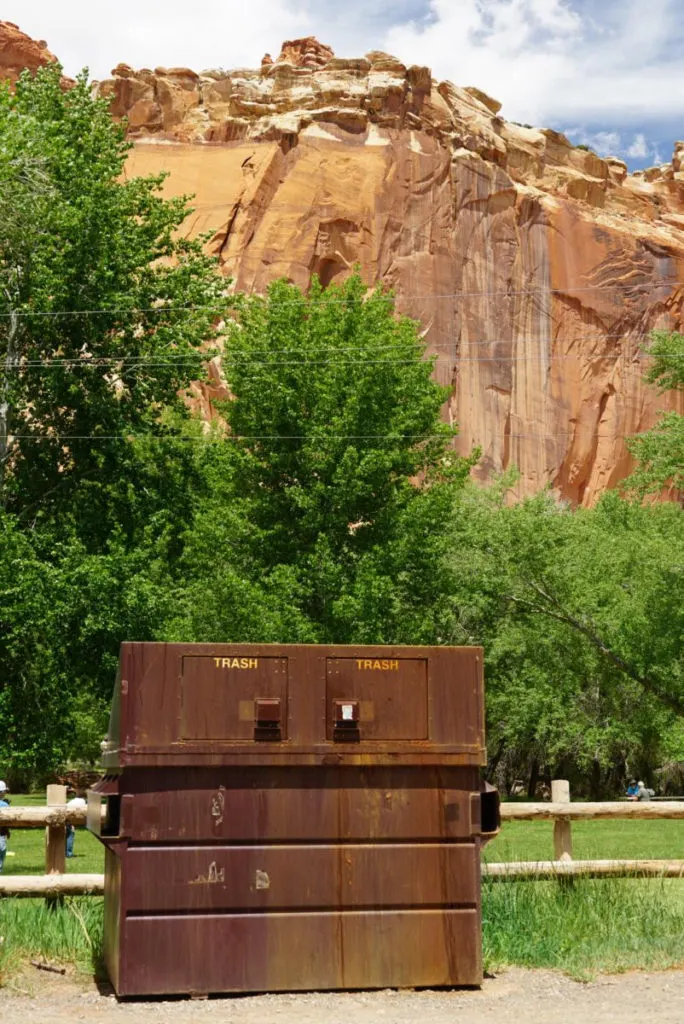
This includes organic waste! Many people assume that things like banana peels, apple cores, pistachio shells, etc are fine to leave out in nature to decompose. While it’s (sometimes) true that they will decompose, this method doesn’t work for three reasons.
- The long process of decomposition leaves plenty of chances for other people to encounter your rubbish. (Thus leaving a trace).
- These organic materials are likely not native to the environment you are introducing them to.
- They break another LNT principle about keeping wild animals…..WILD.
So pretty much everything you carry in with you should be packed out. The only thing you should be leaving behind is urine, and sometimes poop and toilet paper.
Place your trash in a proper trash receptacle, often provided at trailheads, visitor centers, ranger offices, etc. And (when applicable) make sure bear-proof trash cans are latched properly.
Human Waste
Proper disposal of human waste protects water sources from contamination, minimizes the spread of disease, maximizes decomposition, and reduces the likelihood of finding someone else’s “business”.
For going #2, always use any bathroom (if provided).
But in backcountry locations without a toilet, the most commonly accepted method is to use a “cat hole”.
- Choose a site at least 200 feet away from water, campsites, and trails.
- Dig a hole 6-8 inches deep.
- Deposit your waste, limit toilet paper use, and bury.
It’s best to choose an inconspicuous site like thick undergrowth, near downed timber, or on gentle hillsides.
You also should choose elevated sites that avoid water runoff and drainages.
200 feet away from water/camp/trail is a bare minimum distance. It usually needs to be expanded in high-traffic areas. If you choose the first site that looks good, chances are that someone else also thought it was a good spot. (I’ve been there, it’s not very pleasant!)
Choose sites with deep rich soil (typically moist and dark in color). Choose sites with maximum sun exposure because heat speeds up decomposition.
The desert is a little bit of an exception since desert soil is less suitable for decomposition. A key difference is digging a cat hole only 4-6 inches deep to increase sun exposure. Or WAG bags may be necessary (explained below).
Toilet Paper
The use of toilet paper is somewhat debated, (i.e. whether to pack out or bury it).
But generally, you should always minimize your use of toilet paper. And only use plain, white, unscented TP. Or a more advanced-level strategy is using natural materials to wipe (leaves, stones, snow).
Despite the marketing on the package, bio-degradable body wipes are not suitable to be buried in this manner. (You must pack them out). The same with female hygiene products (tampons, pads, etc), they also need to be packed out.
If it’s not required, it’s always bonus points to pack out your TP, but whatever you do, don’t just leave used TP on the ground.
Some environments or locations may have different rules for TP. Burying is sufficient for many places, but packing out TP is encouraged in other places (the desert, above treeline, etc). You should carry a plastic ziplock bag to carry out your TP.
WAG Bags
Many high-traffic areas, river canyons, and desert environments are switching to “WAG Bags” to deal with human waste. The cat hole method in some instances is not sufficient for the environment or volume of visitors.
Instead of catholes, you carry out your human waste and TP in a disposable bag. These special “waste alleviating gel bags”, or WAG bags, are designed to limit odor, absorb moisture, and generally make it pleasant enough to carry out and dispose of in a trash can.
Or river canyons commonly institute mandatory portable toilets to be carried during trips.
Urine
Peeing out in nature (when adequately dispersed) has generally very few negative effects on the natural environment.
Most people learn pretty quickly, that urinating on grasses and other vegetation can help reduce splatter.
However, the salt in urine attracts animals to defoliate plants that have been peed on. So you should prioritize dead plants whenever possible.
Wastewater
Learn to do dishes with minimal biodegradable soap, or none at all. Collect grey water and strain food particles to pack out. Then scatter the remaining water at least 200 feet from water/camp/trails.
Soap and Detergent
Even biodegradable soaps and detergents can have negative impacts on fragile environments. Minimize the use of soaps/detergents and scatter usage, you guessed it, at least 200 feet from water sources.
4. Leave What You Find: Leave No Trace
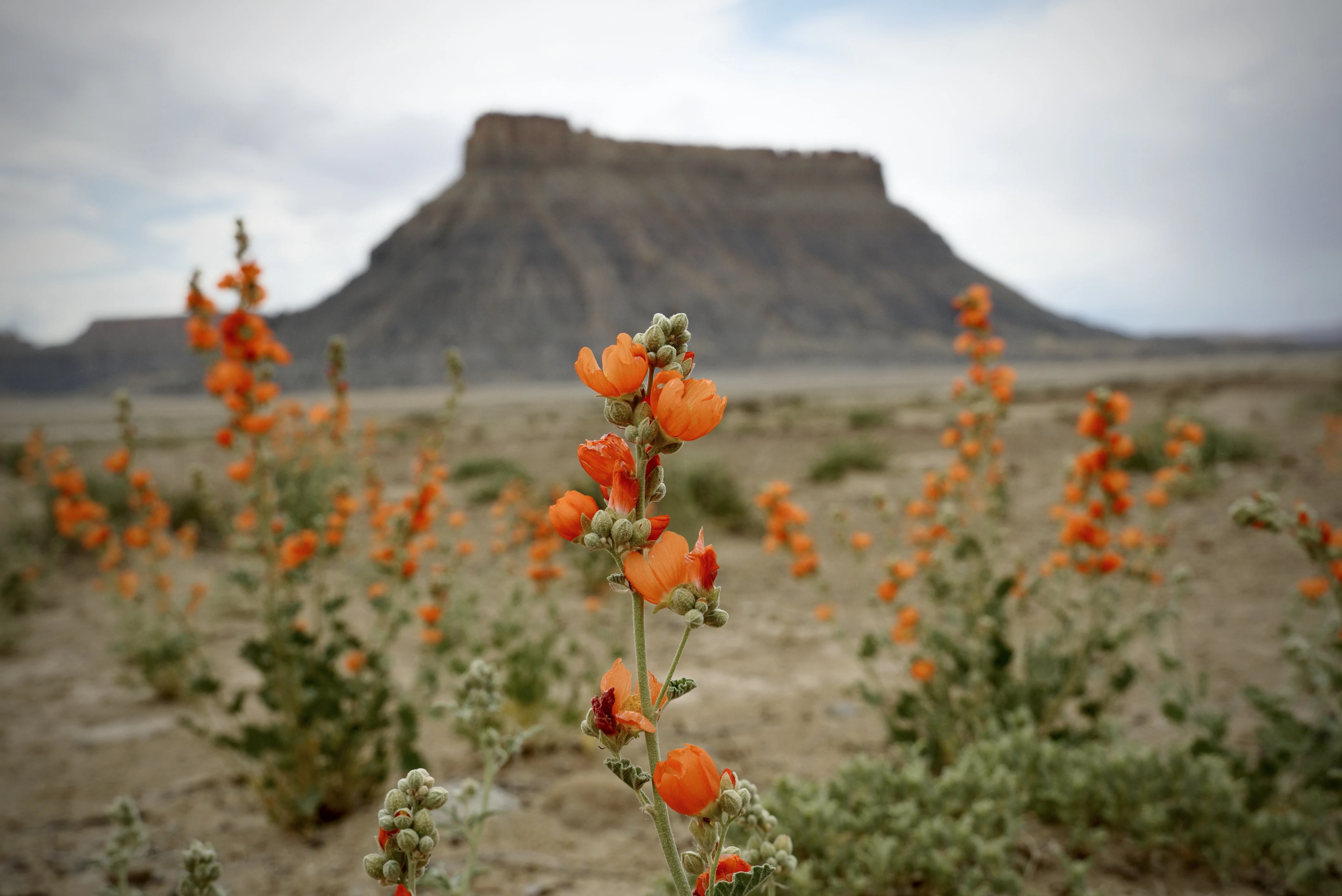
This one is pretty simple. Don’t take anything from the environment’s home with you (only photographs).
People who visit after you should be able to find the same wonders that you did. Removing rocks & plants, damaging cultural artifacts, or carving onto trees or rocks, leaves a worse experience for the people who come after you.
People may often think “it’s just one flower, what’s the big deal?” But this mindset misses the collective impact that hundreds or thousands of visitors with the same excuse will have.
Also don’t make changes or “improvements” to the land, like building additional fire pits, trimming trees/vegetation, digging sites, building structures, etc.
Sometimes bushcrafter culture finds its way into shared outdoor spaces, but these kinds of “improvement” or “survival” tactics should not be done on shared resources.
5. Minimize Campfire Impacts
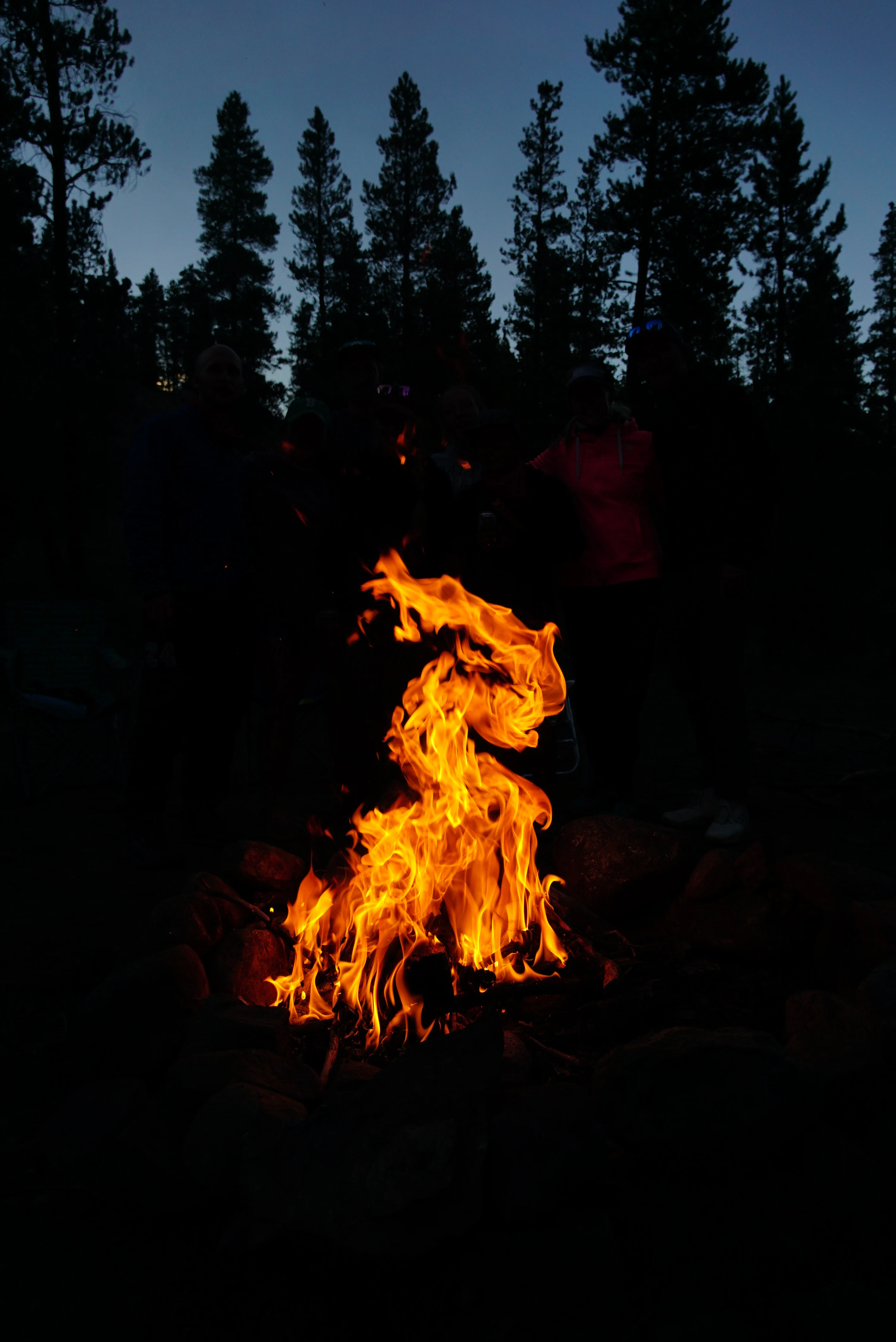
Honestly, there is nothing very “leave no trace” about campfires.
But since fires and camping go together like peanut butter and jelly there is almost no separating the two.
It’s unreasonable to outright ban backcountry campfires everywhere. Hence, the naming of this principle “minimize” campfire impacts.
Modern camp stoves and backpacking stoves make it very possible to camp and cook food without a campfire.
- Make sure that there are no active fire bans in the area you plan to travel.
- Limit campfires to existing fire rings or fire pits whenever possible.
- Put fires out with water so they’re cold to the touch (don’t use dirt)
- Only collect wood when it is allowed, and take only downed wood no thicker than your wrist.
- Avoid having fires in unsuitable environments (high elevation, heavily used areas, or desert settings)
6. Respect Wildlife
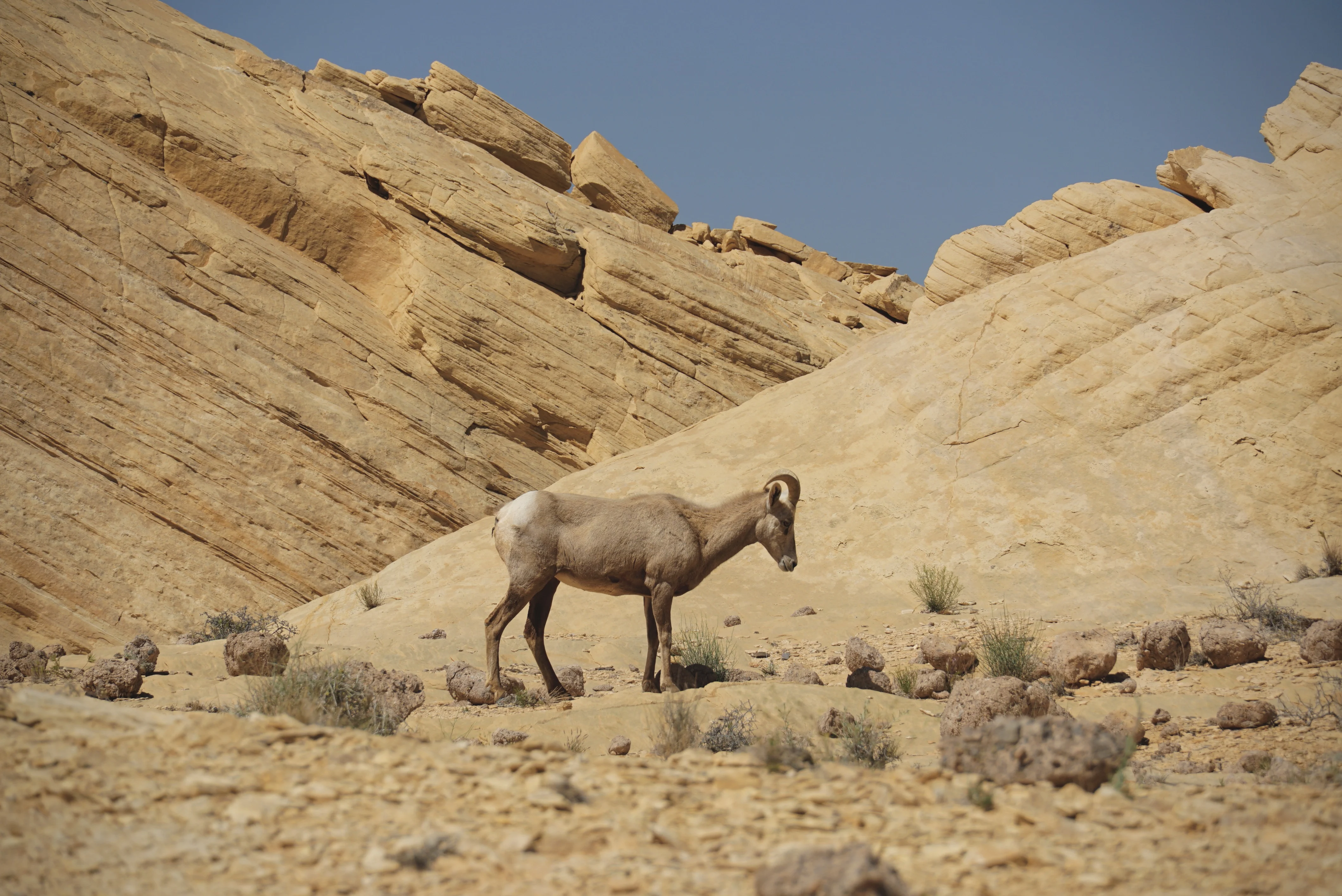
Seeing wildlife can be one of the most memorable experiences in nature. But it must be done with care to ensure that wild animals’ behaviors are not disturbed.
- Keep a safe distance from wildlife.
- Never feed wildlife.
- Store food and any scented items appropriately.
- Camp 200ft away from water sources.
Keep A Safe Distance From Wildlife
Quietly observe wildlife from a distance, and never pursue them. If they flee it wastes precious energy that they need for survival. A good general rule is that wildlife should not have to change their behavior because of you.
The biggest reason people break this rule is trying to get closer for a photo. A telephoto lens is really only the acceptable way to get “close-up” photographs of wildlife.
Bear Safety
An exception is with bears, where making noise is preferred so that you do not sneak up on a bear. Generally, black bears will avoid interactions with humans. And just making some noise is usually all it takes to keep bears from getting too close to you.
Never Feed Wildlife
You should never feed wildlife. When wild animals become accustomed to human food, it increases the likelihood of negative encounters in the future.
Wild animals that aggressively pursue human food may be euthanized (killed) or relocated.
Proper Food Storage
Human food and any scented items (toothpaste, chapstick, sunscreen, perfumes, etc) should be kept away from wild animals.
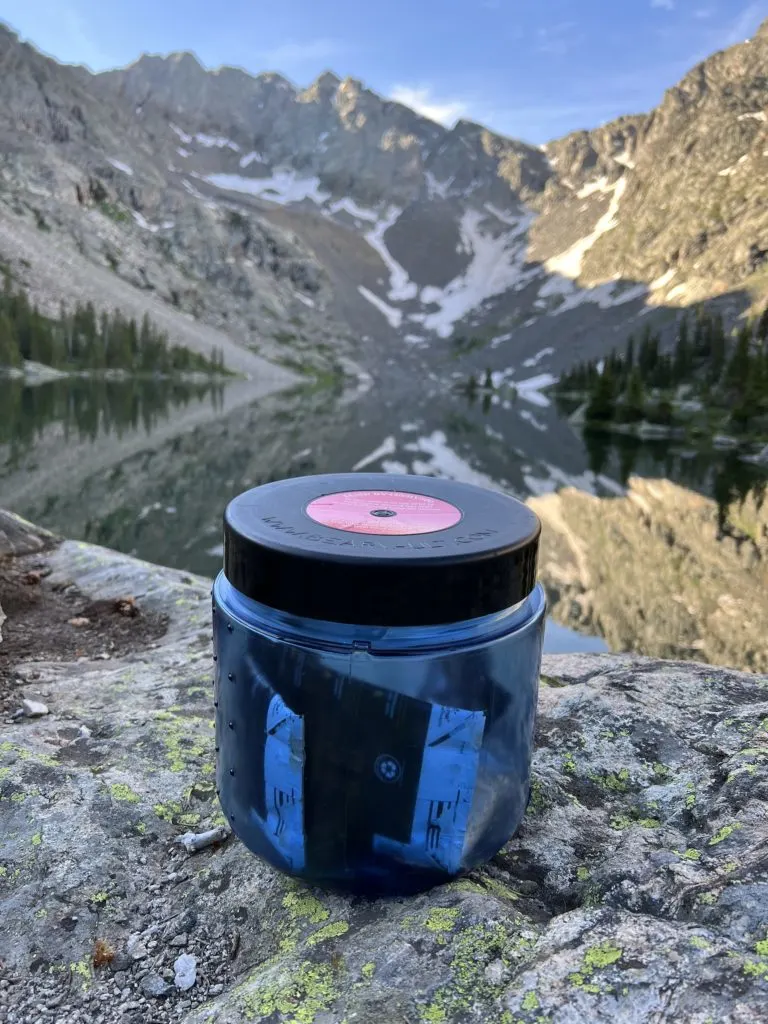
The most well-known storage is the use of bear canisters or bear boxes in bear country. But other environments may require plastic totes or other storage for other critters as well (like deer, raccoons, squirrels, mice, etc).
Protect Animals’ Access To Water
In many sections of the Leave No Trace Principles, we have discussed the “200-ft away from water” rule. That is, choose campsites about 200 feet (70-80 adult paces) away from water sources.
This rule is to ensure that animals have safe and easy access to water without feeling threatened.
Swimming in lakes and rivers is okay in most instances. But try to avoid introducing chemicals from things like sunscreens, bug sprays, and lotions into water sources.
But in arid places like deserts, water resources are much more precious and fragile. Try to limit your use to just drinking water. And avoid going near water sources after dark, when desert animals are more active.
7. Be Considerate Of Others
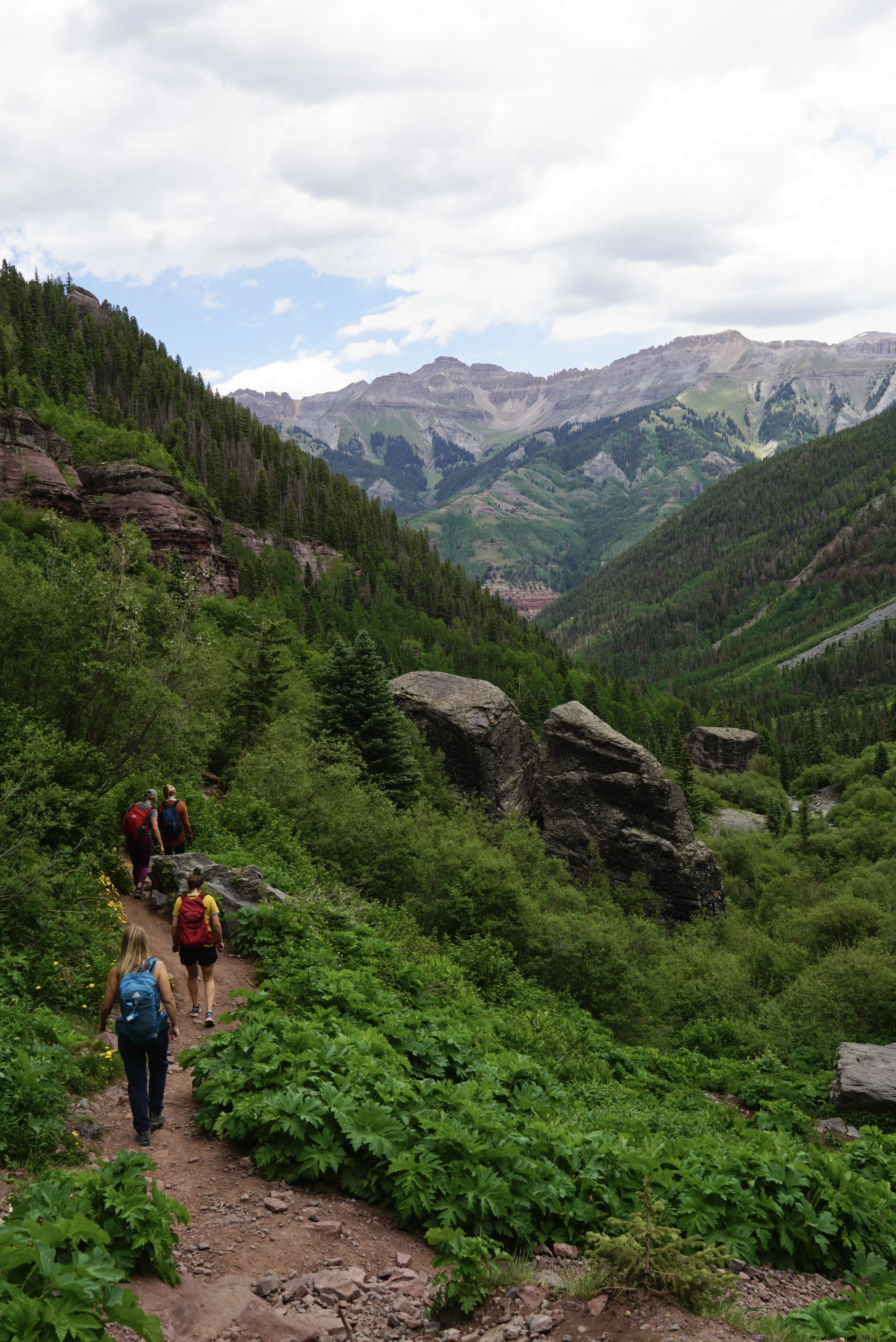
The final principle of Leave No Trace ethics is to be considerate of others.
With an ever-increasing number of visitors to the outdoors, this one is more important than ever. We must work together to ensure that everyone can enjoy their time in shared outdoor spaces.
- Practice good trail etiquette.
- Limit noise and visibility to other visitors.
- Control pets and pick up after them.
Trail Etiquette
Good trail etiquette means following the right-of-way guidelines. Typically, stock traffic (horses) have the ultimate right of way, followed by foot traffic, and lastly, bikers.
People hiking downhill should yield to uphill traffic, because it’s easier to regain momentum when traveling downhill.
Limit noise
A quiet retreat from our modern world is increasingly difficult to find. So limiting noise helps everyone enjoy the peaceful sounds of nature. Basically, treat the outdoors like a library.
Things that commonly break this rule are portable speakers, drones, and groups chatting loudly on the trail. Talking should be kept at lower volumes that don’t disturb others.
And perhaps nothing else draws more vitriol from other users than the use of Bluetooth speakers. Best to just leave them at home. If you absolutely insist on bringing one, make sure that the volume is low enough that others don’t hear it.
Drone Use
Obviously, the use of drones is heavily restricted based on location, so always follow those rules. Drones are always prohibited in all national parks, designated wilderness areas, and most state parks.
But even in areas where you are allowed to use drones, still be considerate of other people. Fly during non-busy times, fly farther away from other people, or sometimes don’t fly at all.
Bear Country Exception
One exception to the noise rule is the need for making noise in bear country (typically with bells or moderate talking).
Other Exceptions To The Leave No Trace Principles
The Leave No Trace principles are simply guidelines, in that they provide a good framework for ethical behavior. But as with most guidelines, they cannot fully account for ALL situations.
So there are some exceptions to these guidelines.
For example, river canyons have their own specific rules (campsite selection, human waste procedures, etc). Or some parts of the Alaskan wilderness are famous for a no-trails approach to travel.
That’s why it’s important to ‘Plan Ahead & Prepare’ for special environments and location-specific rules. So sometimes you need to adapt the LNT guidelines to fit the environment you are in.
Takeaway: Leave No Trace Principles
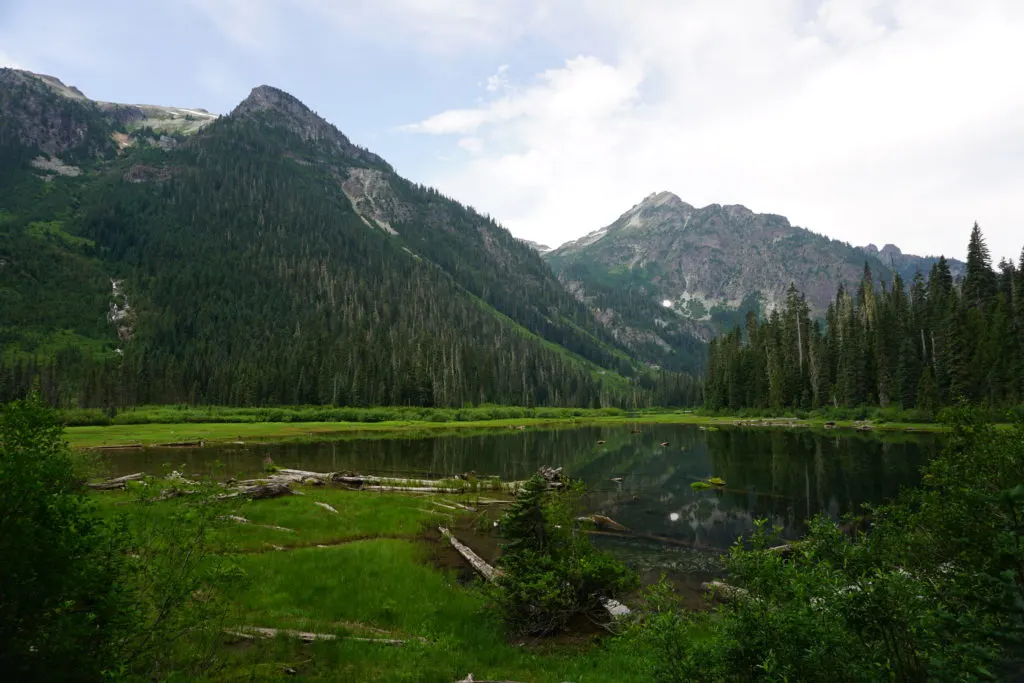
Leave No Trace ethics are more important than ever as we learn to preserve planet Earth. With a massive human population that covers every corner of the globe and no real natural predators, we are truly our own biggest enemy.
So Leave No Trace ethics are a vital part of saving our cherished outdoor spaces so that they are preserved for generations to come. They allow a growing number of people to share a finite resource without loving them to death.
This post has been our summary of what we think are the most important highlights of Leave No Trace ethics, but you can learn more on the Leave No Trace website.
After years of practicing LNT ethics, we find that they eventually become just part of how we carry ourselves through the world. We hope that Leave No Trace ethics become part of your routine too.
So that we can all be just a little bit nicer to the only planet we have.
Please Share These ‘Leave No Trace 7 Principles’ With A Friend

